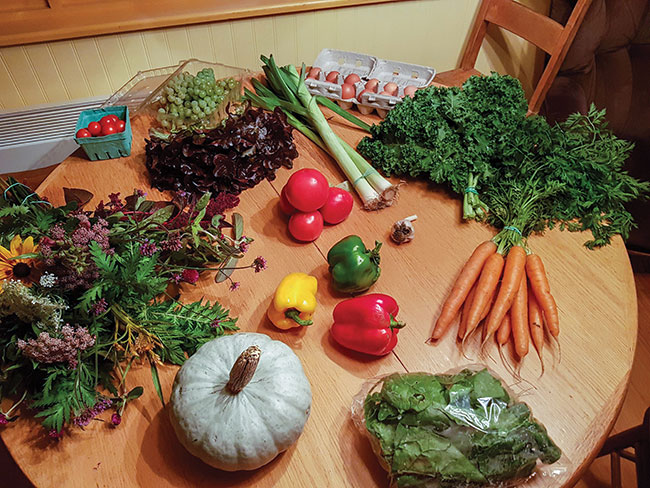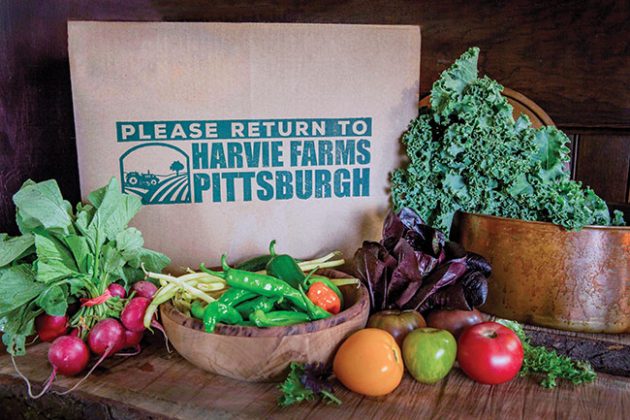
Features
We got an influx of CSA subscribers, now what?
How CSA farms handled the rush of subscribers during the pandemic, and what it takes to keep them around.
December 7, 2020 By Steph Coelho
 Thériault says that Ferme Coopérative Tourne-Sol, which already has an excellent retention rate, tends to stick with their usual tactics of sending out newsletters with tips for cooking basket items and having an active Facebook group. scientist Samir Debnath decided that he would change that. Photo courtesy of Frédéric Thériault.
Thériault says that Ferme Coopérative Tourne-Sol, which already has an excellent retention rate, tends to stick with their usual tactics of sending out newsletters with tips for cooking basket items and having an active Facebook group. scientist Samir Debnath decided that he would change that. Photo courtesy of Frédéric Thériault. At the height of the COVID-19 pandemic, many people scrambled to get their hands on Community Supported Agriculture (CSA) shares. Growers on Harvie, an online tool that connects consumers to local farmers, saw a surge of interest this year. Simon Huntley, CEO of Harvie, says the interest represents a nearly 500 per cent increase in sales on the platform, which works mainly on a subscription basis. While some growers opted to stick to a predetermined plan, others elected to take on more subscribers than usual. In either case, CSA providers must find ways to adapt and respond to the situation imposed upon them by a global pandemic. How can farmers handle growing interest? The solution to the puzzle involves implementing customer retention strategies, which include a heavy dose of exceptional customer service.
Frédéric Thériault, who is in charge of CSA registrations for Ferme Coopérative Tourne-Sol in Les Cèdres, Que., points out that the current interest in local foods is “rooted in people’s own desire for safety and food security.” David Greenberg, co-owner of Abundant Acres farm in Nova Scotia, says that his operation saw a marked increase in mainstream shoppers. Getting people to sign up this year was a breeze, Greenberg says, adding that “this is the first time we’ve sold out our CSA for years and years.” He admits that the team isn’t stacked with sophisticated marketers but doing more targeted advertising on Facebook and Instagram is something he thinks the farm is ready to begin doing, though, it wasn’t necessary at all this season.
Early renewal campaigns help successful CSA farms, like Tourne-Sol, get a foothold on subscriber numbers well before the start of the season. Having a definite number of subscribers in late fall/early winter provides both security and capital. “It was certainly a lot easier to acquire customers this year than in the past. But I think what I’m talking to a lot of farms about is how do we set ourselves up for success in the long term . . . The same things that were true before the pandemic are going to be true afterwards,” Huntley says. Thériault explains that despite the enthusiasm from would-be subscribers, the plan is not to strain the farm’s limits. Instead, the farm intends to focus on growing its seedling production since many people have discovered a new (or renewed) interest in gardening during quarantine.
Thériault also reveals that a big part of the farm’s success in acquiring new subscribers is the farmer’s network, Réseau des Fermiers de Famille. The Quebec-wide network enables consumers to easily locate CSA farms with nearby pick-up points. They can sign-up and track their baskets throughout the season using the website. Subscribers pay a nominal fee that goes toward creating a public awareness campaign promoting the concept of community-supported agriculture. Network farmers also rely on one another for support. “When farms are in trouble, we can help each other out,” Thériault adds. With a core group, Tourne-Sol has rarely had to implement heavy-duty recruiting strategies or costly marketing campaigns. Instead, the focus lies heavily on retaining customers from year to year.
Keeping subscribers around
How can farms keep highly-motivated, new subscribers as they move into the new year – one perhaps without the looming threat of COVID-19? “Give the people what they want” is a familiar echo among farmers like Huntley, Greenberg, and Thériault. And it’s not unique to pandemic times.
Thériault says that Tourne-Sol, which already has an excellent retention rate, tends to stick with their usual tactics of sending out newsletters with tips for cooking basket items and having an active Facebook group. These strategies help customers, particularly those new to the CSA way-of-life, get acquainted with their basket contents and keep them tuned into farm life, which in turn, fosters a deeper relationship between grower and subscriber.
Greenberg’s business model, a market-style operation, is different from the usual pre-selected basket share. He explains that being open several days a week is a huge advantage. The CSA, which accounts for about 40 per cent of sales, also benefits from a central location and pick-and-choose style setup. Greenberg is adamant that giving customers a breadth of choice helps immensely with the CSA’s retention rate.
Simon Huntley explains that farms in the Harvie network have seen a growing interest in home delivery, an initiative that has accelerated recently because of COVID-19. Farms are innovating in other ways too. Huntley points to better technology, like his platform Harvie, and a willingness to work with other producers as top examples of how farmers can expand and improve upon their CSA services and encourage people to re-subscribe.
Thériault admits that it’s not always possible to grow everything. Some foodstuffs, like fruits, flowers, and honey, require particular expertise. Reaching out to and working with other producers delivers additional value to CSA shares and prevents growers from stretching themselves too thin.

Simon Huntley explains that farms in the Harvie network have seen a growing interest in home delivery, an initiative that has accelerated recently because of COVID-19. Photo courtesy of Harvie Farms.
Achieving customer service excellence
Delivering excellent customer service is paramount for growers who wish to expand CSA-related business activities and keep people coming back from year to year. An important part of providing quality customer service, Thériault explains, is digging into customer experiences using tools like end-of-season surveys to find out where things are going well and where there may be a need for improvement.
Additionally, unlike many direct-sale growers, CSA farmers must often take on the task of cultivating relationships with subscribers. “If you’re going to be a farm that’s going to sell direct to consumer, then that’s the cost of doing that business,” Huntley says. Customer interactions, as he puts it, are “where the rubber meets the road.” Unfortunately, for some, a knack for customer service is not an innate quality.
Huntley refers back to the Harvie platform, which he describes as the “Amazon of CSA delivery.” It essentially offloads most of the customer-facing duties from the grower and passes them onto Harvie support staff. “We provide lots of tools for home delivery, we can provide things like packaging for home delivery, we can provide courier services in different areas,” Huntley explains. However, farmers without a similar platform at their fingertips may struggle to deliver on this front simply because formal training is not readily available.
Thériault adds that while some customer service basics are apparent (e.g., be friendly, polite), he understands that some CSA farmers might need an extra hand. He eagerly plugs the Quebec farmer’s network, which occasionally offers up training sessions on various topics during the winter months. Other networks like this exist throughout Canada. Young Agrarians, for example, though not CSA-specific, brings together a similar network of like-minded growers. The organization hosts events and offers business apprenticeships and mentorships aimed at budding farmers. Their website also contains a variety of helpful CSA farming blogs, including one specifically on small farm and CSA management tools.
Thériault also brings up mydigitalfarmer.com as a tool he recommends. The site is spearheaded by Corinna Bench, who runs a successful 400-member CSA along with her husband in northwestern Ohio. While the information there is not necessarily customer service specific, Thériault explains that many of the marketing tips may help floundering farmers who have little customer service experience.
Looking forward
What is in store for 2021? It’s a question Huntley asks himself often. He suggests that people have likely created new habits in this short time, which bodes well for the future. It’s too early to definitively say whether new and keenly interested CSA subscribers will return to sign-up in the new year, but it’s clear that there is a growing demand for local food. Enticing people to come back involves a multi-faceted approach. A quality product – a no-brainer – and excellent customer service are perhaps two of the most important puzzle pieces for a CSA operation to flourish.
Print this page